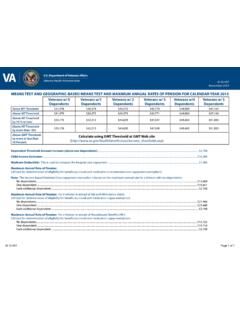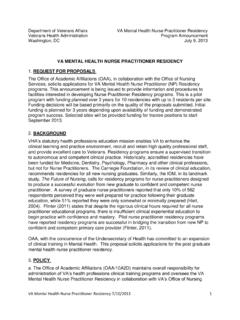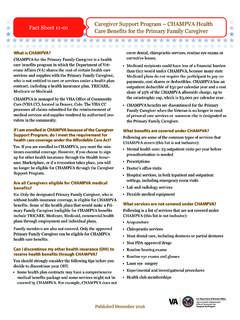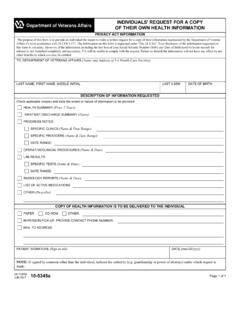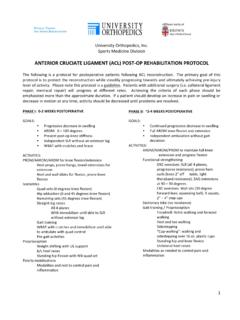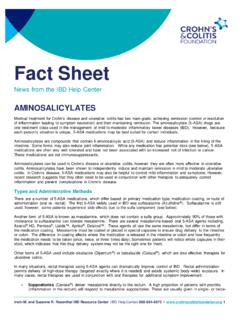Transcription of Eating to Reduce Inflammation - Veterans Affairs
1 WHOLE HEALTH: INFORMATION FOR Veterans Eating to Reduce Inflammation Whole Health is an approach to health care that empowers and enables YOU to take charge of your health and well-being and live your life to the fullest. It starts with YOU. It is fueled by the power of knowing yourself and what will really work for you in your life. Once you have some ideas about this, your team can help you with the skills, support, and follow up you need to reach your goals. All resources provided in these handouts are reviewed by VHA clinicians and Veterans .
2 No endorsement of any specific products is intended. Best wishes! Eating to Reduce Inflammation Page 2 of 7 Eating to Reduce Inflammation What is Inflammation ? Inflammation is one of the body s ways of protecting itself. It helps fight off infections, increases blood flow to places where healing is needed, and signals us, through pain, that something is wrong. But if Inflammation levels are too high, or if a person stays in an inflamed state for too long (has chronic Inflammation ), it can lead to disease. What diseases are associated with unhealthy Inflammation ?
3 Many diseases are linked to Inflammation . These are often chronic (long-lasting) diseases, which can be very hard to treat. Here are some examples:1,2 Alzheimer s disease Asthma Autoimmune diseases (diseases where the body is attacked by its own immune system). These include rheumatoid arthritis, scleroderma, and lupus. Cancer Chronic obstructive lung disease, also called COPD (emphysema and bronchitis) Chronic pain ( back pain, neck pain, headaches, arthritis) Depression Heart disease Inflammatory bowel disease (Crohn s or ulcerative colitis) Type 2 diabetes Obesity There are many others as well.
4 What they all have in common is that they can often be prevented or reduced if you focus on Eating some foods and not Eating others. This way of Eating is often called the Anti-Inflammatory Diet. Unlike other diets, an anti-inflammatory diet is not meant to be a diet for losing weight. It supports your health in other ways. How do I eat an anti-inflammatory diet? It is thought that over 60% of all chronic disease could be prevented if people ate a healthy What does that diet look like? Some of the most important parts of it are listed Choose any one to start out.
5 Over time, you can add others at a pace that works for you. The Anti-Inflammatory Diet: Top Ten Suggestions 1. Pay attention to proteins. If you get most of your proteins from plants like beans, whole grains, and nuts, your levels of Inflammation will be lower. If you eat red meat, it is best to eat grass-fed meat or wild game rather than grain-fed Wild-caught (as opposed to farmed) fish can be a great source of protein. As journalist Michael Pollan says in his book Food Rules, The fewer the feet, the better the meat. 6 2. Eat more fiber.
6 Fiber, which is a form of carbohydrate, lowers Read food labels. Different groups suggest different daily amounts, but try for the following: Women 19-50 years old: 25 grams daily Eating to Reduce Inflammation Page 3 of 7 Men 19-50: 38 grams daily Women over 50: 21 grams daily Men over 50: 30 grams daily Good sources of fiber include whole grains, oatmeal, nuts, berries, beans, vegetables, brown rice, and popcorn. Potato skins have a lot of fiber. If you don t already eat much fiber, increase your intake of these foods slowly to avoid bowel discomfort.
7 3. Eat your vegetables and fruits. When it comes to ideas for healthier Eating , Eating more fruits and vegetables is usually at the top of the list. In addition to their many other benefits, vegetables and fruits Reduce Inflammation . Berries and cherries are especially good options. Fruit j uice is not usually a good choice because it is high in sugars and low in fiber. Making your own smoothies is a good idea. Choose dark colored produce that is many different colors. Plants get their colors from phytonutrients, helpful compounds that are anti-inflammatory.
8 Strive for a minimum of 5 cups of vegetables and fruits per day. If you have diabetes or pre-diabetes, emphasize non-starchy vegetables over fruits. 4. Use more anti-inflammatory herbs and ,9 A 2012 study found that some of the best anti-inflammatory spices to eat, in order, are paprika, rosemary, ginger, turmeric, sage, and cumin. An earlier study looked at other chemical properties of spices and found that cloves, ground Jamaican allspice, cinnamon, sage, marjoram, and tarragon are also great choices. Guidelines 5 -8 are related to fats.
9 In the body, different types of fats are processed in different ways, which can either increase or decrease Inflammation . 5. Avoid trans-fats. Trans-fats, which are added to foods to increase their shelf life, can add to the body s Inflammation . Avoid foods that have labels saying they have partially hydrogenated oils. Foods that often have trans-fats include baked goods ( cakes, piecrusts, frozen pizza, and cookies) and fried foods ( donuts, fries). 6. Limit saturated fats. Most (not all) saturated fats also promote Inflammation .
10 These fats mostly come from animal sources such as meats (lamb, pork, chicken with skin, fatty beef), and dairy products like milk, cheese, cream, and butter. If you eat meat, a good general rule is to try to eat white meats, fish and other seafood. Saturated fats from plants (coconut and palm kernel oils) may not be as much of a problem. 7. Balance omega-6 s and omega-3 s. You may have heard about essential fatty acids. These are types of polyunsaturated fats that your body can t make on its own. You have to get them from your diet.



